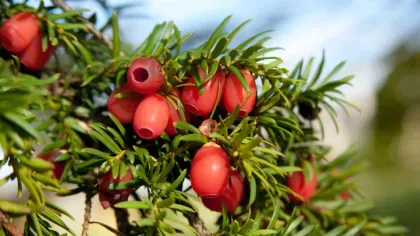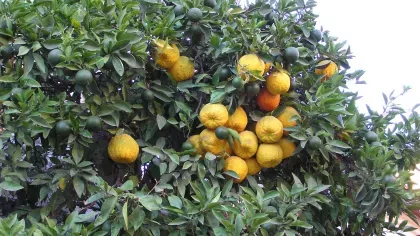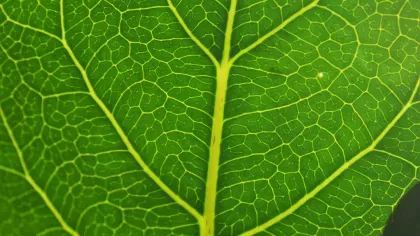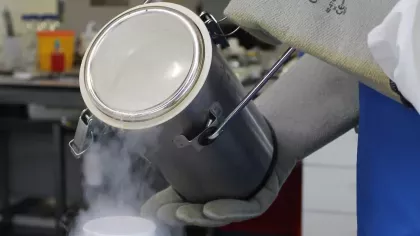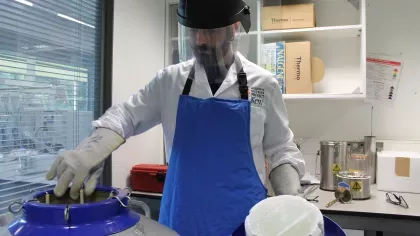
Avocado
On this page
From Mexico and Central America, the evergreen avocado plant is well known for its edible, green-fleshed fruits.
Not just a salad bowl favourite, the fruit are a key ingredient in dips, smoothies and even ice creams.
Avocado plants also make attractive houseplants that can easily be grown from the seeds of supermarket-bought fruit.
There are two main cultivated varieties (cultivars) of avocado: Persea americana ‘Fuerte’ and Persea americana ‘Hass’. The first has shiny, smooth, green skinned fruit; the second has dark purple, knobbly, thick-skinned fruit.
Plant description
An evergreen tree or shrub with a rounded crown. The leathery leaves are dull and dark green on the upper surface and pale green on the lower surface. They smell like aniseed when crushed. The small, greenish, fine-haired flowers grow in clusters at the end of branches. Both male and female flowers grow on the same plant but they mature and open at different times to avoid self-pollination. The pear-shaped fruit have thick, dark green to purple skin; greenish-yellow, edible flesh; and a single, large, rounded seed in the centre.



Plant uses
Beauty and cosmetics
Avocado oil is added to skincare products as it moisturises and nourishes skin.
Cultural
Avocados are grown as ornamental houseplants for their aromatic foliage. If kept at room temperature, the plant will grow from a seed potted in compost or partially submerged in water.
Food and drink
The flesh of avocado fruits is highly nutritious and often eaten in salads, dips (such as guacamole), smoothies or simply on toast.
The avocado has been eaten in Mexico for over 10,000 years. Here, and in Central America, the aromatic avocado leaves are used in bean and pulse stews, and to wrap bread or cheese.
In Brazil, parts of India, and some countries in Southeast Asia, avocado fruit are frequently found in milkshakes, ice-creams, and other desserts.
Avocado honey, which is made from the nectar of avocado trees, is commonly found in farmer’s markets in Southern California and Mexico.
However, some people experience allergic reactions after eating the avocado fruit and parts of the plant can be poisonous to some animals and birds.
Health
Avocado is used to manage diabetes in Central America.
Avocados have high amounts of potassium and low amounts of sodium, which is beneficial for people on low sodium diets and may help protect against high blood pressure and cardiovascular diseases.
They are also rich in vitamins which helps boost general health and wellbeing.
Materials and fuels
A milky fluid extract from avocado seeds has been used as an ink to mark cotton and linen.
Did you know?
Avocado fruit are, botanically-speaking, berries that contain a single, large seed.
The common name, avocado, comes from the word ‘ahuácatl’ in Nahuatl (a Mexican language) meaning testicle. It refers to the shape of the fruits and led some to believe they increase fertility.
Since male and female flowers on an avocado plant open at different times to avoid self-pollination, avocado orchards must include cultivated varieties that have different flower opening times to make sure pollination occurs and fruits are produced.
In Kew’s archives, there is a letter that was sent on behalf of King George V in 1916, asking how His Royal Highness should encourage his avocado pear to fruit. Kew responded offering practical advice and reassuring the King that ‘flowers were produced on a plant at Kew in 1851’.
The avocado crop requires a lot of water which means the dry regions where commercial crops are grown, such as Israel and South Africa, are facing more intense droughts.
The fruit of wild avocado plants have shiny, almost black skin that is very thin, like a tomato.
Where in the world?

Moist, tropical, evergreen or montane forest, and lower slopes of rainforests, with well-drained soils.
Find it in our gardens
Kew Gardens
A botanic garden in southwest London with the world’s most diverse living plant collection.
Location
View map of Kew GardensBest time to see
Our work
While the avocado is widespread in cultivation, its diversity is threatened by global demand for the popular Persea americana ‘Hass’ cultivar.
The species is also threatened by the fungus Phytophthora cinnamomi which causes root rot.
Ongoing work by scientists at our Millennium Seed Bank may be crucial for the future conservation of avocado.
Many seeds can be preserved for centuries when dried and stored at -20°C. However, some seeds, known as recalcitrant seeds, are sensitive to the drying process and do not survive.
Recalcitrant seeds require an alternative preservation approach. One such method is known as cryopreservation - using liquid nitrogen to rapidly cool down the seeds and then store them at very low temperatures (often -196°C).
Our scientists have been working with this method for over 30 years, investigating seed responses to drying and liquid nitrogen exposure.
Whilst recalcitrant seeds from the avocado plant are yet to be stored in our Millennium Seed Bank, developments in cryopreservation are vital for long-term conservation of this valuable species, among others, to protect biodiversity and ensure food security.
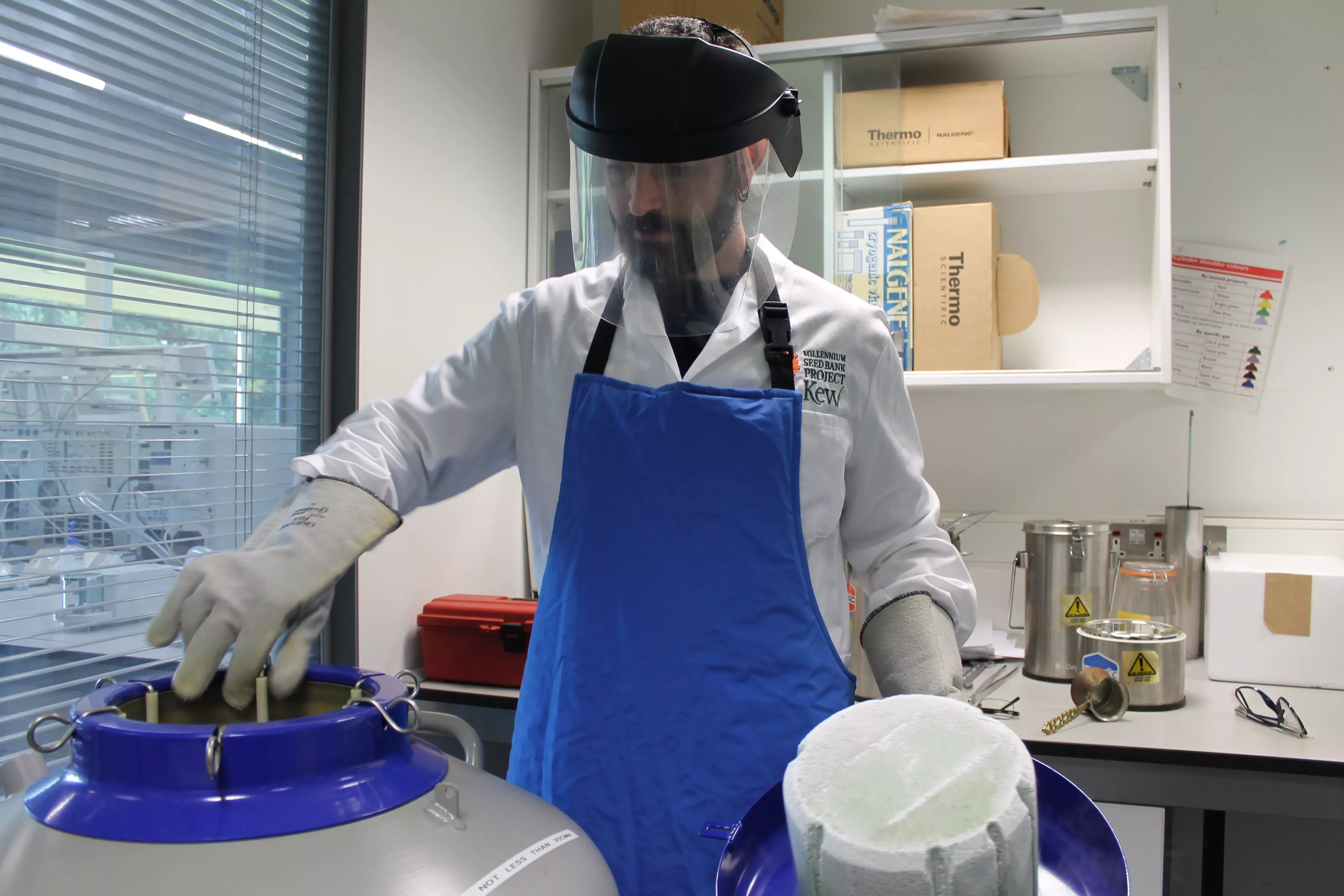
In a study of traditional anti-malarial plants in the state of Roraima, Brazil, a Kew scientist recorded 22 plant species used by the Wapixana indigenous people to treat malaria.
This included fallen avocado leaves mixed with the roots of southern sandbur (Cenchrus echinatus), and an extract made by boiling the avocado stone with licorice weed (Scoparia dulcis).
The avocado plant is also used to treat malaria in Peru, Ghana, Nigeria, Guinea, Congo, and Cameroon.
